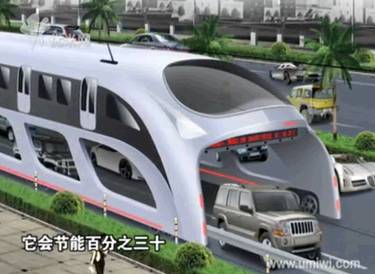Yes, the Chinese straddle bus is back. “Back” because you read about it here six years ago. A wide flat vehicle that spans the travel lanes of an expressway, so that cars can drive under it. As I observed back then, its most interesting feature is the way it collapses what little remains of the difference between bus and rail.
And yes, if your starting point for urban design is that single-occupant cars, despite their extreme inefficiency in using scarce urban space, should be allowed to go anywhere at all, and that the surface plane should be designed solely for their convenience to the exclusion of all other citizens and needs, then this technology makes sense.
Remember, the primary cost of transit infrastructure is the cost of keeping transit out of the way of motorists, on the assumption that motorists have the prior claim to absolutely every bit of public space in our cities.
Meanwhile, Cap’n Transit has the best parody. Not that I don’t take this seriously, at least as a scalpel for prying open the deep assumptions of infrastructurism.

I actually think the “straddle bus” itself might be something like a “scalpel for prying open the deep assumptions of infrastructurism”, or a “reductio ad absurdum” for the combination of current ideas about transportation planning, which are all so deeply held that some people would rather believe the absurd than question those ideas.
Or maybe the “straddle bus” is a Rorschach Test: each person’s reaction to it reveals more about their own ideas than the proposal itself.
Cap’n Transit parody of the straddle bus is actually a clip from the movie “My Neighbor Totoro,” which features the mystical Catbus, part creature, part vehicle.
I’m really wondering how the monster can turn without destroying the cars below.
And, if it only goes straight away, how can the cars below turn?
Seems that a monorail or a subway would do the same job(i.e. transporting zounds of people without disturbing the precious drivers) better(the precious drivers are actually undisturbed).
But yes, Al Dimond, I like your Rohrsach test reference. Such a strange and disruptive idea(even if not really clever) pushes everyone to look deep inside him/herself to find answers. Very revelative. My own reaction comes from my habit to ask “can it work?” before even “is it good?”.
Is there any word on whether the Chinese are actually bending metal to build this? The first track was supposed to be ready for tests in 2010, and nothing happened, for very good reasons. From what I gathered in the western media, the thing was deemed too costly. Is there anything besides hype going on this time?
Even if you accept that all available surface in urban places should be reserved for private cars, it should still be obvious that this thing has the disadvantages of surface traffic (level crossings) at the cost of a grade-separated system. In other words, it’s a rivetingly stupid idea.
this is supposed to be cheaper than elevated or underground rail, more like a tram, but I bet it isn’t. The fact that it’s entirely proprietary and non-durable doesn’t help.
Also it can’t even work because if an exit is blocked by a car because of traffic, you’re done. Smashing into it at fast speed, or being blocked like a bus.
It’s mind-boggling that someone would seriously think about this instead of converting 2 lanes to BRT lanes or something.
The only possible place to build something like this would be in those super-roads without trees they have in asian cities, where removing 2 lanes shouldn’t be a problem really.
Let’s try to analise the project.
The vehicles will cover two lanes on a freeway. If it were just one lane wide, would be really dangerous. A width of two lanes it’s more “free” underneath, but has its cost: maneuverability. A wider carriage means curves with more radius.
I can see a problem with that width: the road has to be two lanes or less, because more lanes means that one of the wheels needs to be in the middle of the road (as in the scale model of the video). But, motorists tend to not follow the rule of “keep your lane”, and sometimes they occupy the markings in-between and also, in this case, the rail (or optic guidance markings).
It has an easy solution: let’s make the rail a bit taller, putting it on a barrier (Jersey barriers maybe?). But it has another problem: it divides permanently the freeway. Ok, no problem: make them really tall, like a viaduct, with holes so cars can pass underneath.
So, we have a really wide train, with elevated rails, and now we’re free to lay rails wherever we want, without the constraint of the freeway. So, as the width of the train was a pretext to put the vehicle on a freeway, now we have the freedom of decide the most efficient width. The only variable is maneuverability. With narrower carriages, we can build tracks with more flexibility. So, we choose the width of a traditional train.
Now we have two viaducts, running traditional trains in each direction. Where I saw them? Mmm… let me remember…
And they said it’s cheaper…
Hi All,
The Chinese will always be fascinating in all they do.
Regards.